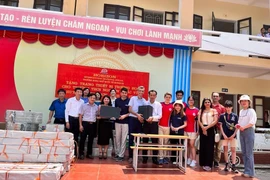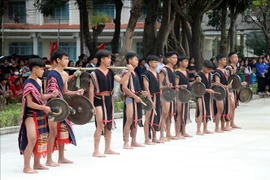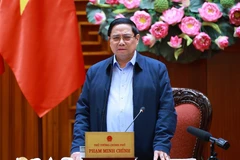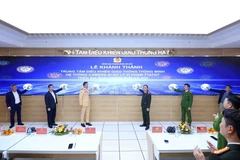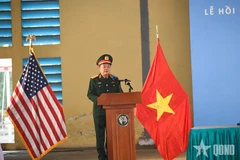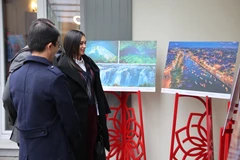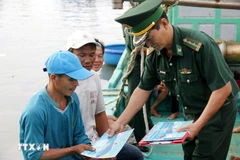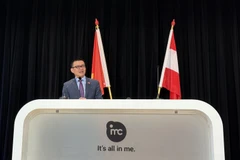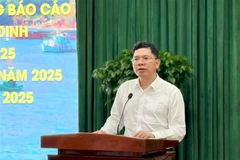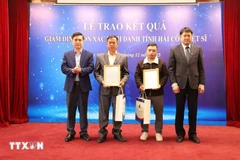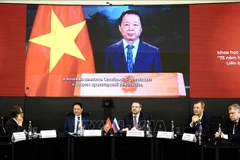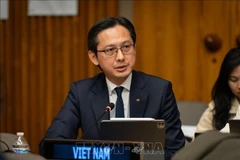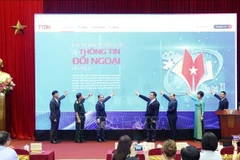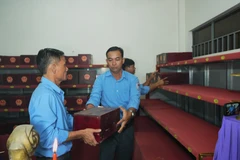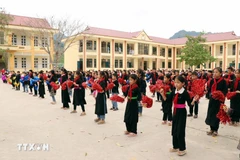 A Mong ethnic student in Nghe An province learns how to write in his mother tongue. (Photo: giaoducthoidai.vn)
A Mong ethnic student in Nghe An province learns how to write in his mother tongue. (Photo: giaoducthoidai.vn) The Nhon Mai Semi-boarding School for Ethnic Minorities is located in one ofthe most remote communes in Tuong Duong district, central Nghe An province.
Most of the school students are of Mong ethnicity, followed by Kho Mu and Thai.
In accordance with the optional subjects in the new general educationprogramme, Mong and Thai students can sign up to learn their ethnic languages.
However, the case is not the same for Kho Mu students, even though theyoutnumbered the group of Thai students at the school.
As the optional subject of Ethnic Language only offers Bahnar, Cham, Ede,Khmer, Jrai, Mnong, Mong and Thai languages, Kho Mu students have no textbookor teacher to learn theirs.
Tran Duc Quy, the school’s deputy dean said: “They are still very young, sothey are not fully aware of the importance of language and writing in theirethnic cultural identity.
“Therefore, the enrolment for ethnic language courses depends on theattentiveness and encouragement from the teachers.
“However, from the viewpoint of parents and people, if we only have Thai and Monglanguage classes and none for Kho Mu, there will be comparisons and concerns.”
Vo Tuyet Chinh, deputy head of Tuong Duong district’s education and trainingdivision, said that the locality is the largest mountainous area in Nghe An province,and is home to multiple ethnicities.
“Teaching ethnic languages is a way to preserve and promote the ethnic identityfor students. This is also a mission of education in the mountainousareas," said Chinh as quoted by the Giao duc & Thoi dai (Education& Times) e-newspaper.
“However, the implementation process faces multiple challenges, includingteaching materials and personnel.
“We hope a detailed guideline will soon be issued before we get to work.”
Meanwhile, the Thong Thu 1 Primary School in Que Phong district is stillweighing the optimal solution regarding language teaching.
Tang Xuan Son, the school’s dean said that the majority of the students hereare of Thai ethnicity, and they all use their mother tongue in their community.
However, the primary school does not yet teach them how to read and write Thai,as the local dialect has certain differences compared to the teaching materialsavailable.
Therefore, the school is considering using the two weekly elective periods forEnglish or supplemental Vietnamese classes.
This would help them with communication and a better understanding of thetextbooks in the new education programme.
In Ky Son district, the Dooc May Primary School has been holding Mong languageclasses for several years.
All of its pupils are of Mong ethnicity, and therefore are excited to learn toread and write in their mother tongue, said the school’s dean Tran Huu Truong.
With his years of experience in the local education sector, Truong agreed thatteaching ethnic languages is very difficult in schools whose students are ofvarious ethnicities, instead of just one like Dooc Mạy commune.
He also shares the perspective that in these schools, students can utilise thetwo elective periods for English, if there are enough teachers, or foradditional Vietnamese lessons.
Truong explained that ethnic primary schoolchildren tend to have difficulty inunderstanding the national language, and therefore take more time to learncompared to those who have the official language as their mother tongue.
These could also be beneficial for younger students when they go to the thirdgrade and foreign language is a compulsory subject.
Thai Binh Duong, who is in charge of ethnic minority affairs at the Nghe AnProvincial Department of Education and Training, said that based on theregistrations submitted by local schools, the department will help organiseethnic language classes when there is sufficient teaching materials andteachers in charge.
They are also working on an alternative option for students whose ethniclanguage is not among those included in elective courses in the new generaleducation programme to ensure the children’s benefits./.
